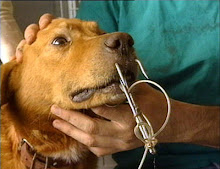Friday, June 24, 2011
Are You A Diabetic And Own A Dog
Dog Consumed Part Of A Sleeping Patient's Toe: Case Study To Highlight The Danger Of Pets In The Presence Of Open Wounds
In a case study that illustrates the need for people with diabetes to be cautious of foot injuries and to protect themselves from pets, a woman with numbness in her feet caused by diabetic neuropathy slept through a traumatic episode in which her Jack Russell terrier chewed off part of her slightly infected big toe, according to an article published in this month's issue of the Journal of the American Podiatric Medical Association.
The patient's wound required surgery, and it ultimately led to the amputation of her leg, leaving her a double amputee.
The case study, co-authored by Valley Presbyterian Hospital specialist Lee C. Rogers, D.P.M., is only the second of its kind to be published in the medical literature, although more cases like it have been reported in the media. This case highlights the need for diabetic patients with neuropathy to avoid having their feet or wounds exposed when sleeping with their pets.
"Pets have a tendency to lick wounds, and that simple lick can turn into a bite, if there is no response from the owner. There have also been reports of dogs' saliva infecting diabetic patients with the antibiotic-resistant Superbug, MRSA, which can be deadly," Dr. Rogers said. "This case illustrates the perils of pet ownership in diabetic patients who have numbness in their hands or feet caused by neuropathy."
The Centers for Disease Control estimate diabetes affects 25.8 million Americans - or 8.3 percent of the population - and report that it is the leading cause of non-traumatic amputations. In this case, the 48-year-old woman didn't feel any pain and only realized part of her toe was missing when she awakened in the morning and found blood in her bed and on the floor.
She was sleeping with her 2-year-old Jack Russell terrier and realized it must have chewed off part of the toe during the night because the dog had blood in its facial fur. Doctors amputated part of her toe and, later, the lower portion of her leg because she developed other infections and neuropathic ulcerations, skin lesions that are common in diabetics who suffer from numbness.
"People with diabetes and neuropathy must take special precautions to protect their feet from infections to avoid amputations and other complications," said Dr. Rogers.
Dr. Rogers is the associate director of Valley Presbyterian Hospital's Amputation Prevention Center, an integrated limb-preservation center that is one of the nation's only facilities of its kind. Since its January 2010 opening, the Amputation Prevention Center's specialized multidisciplinary team of highly skilled professionals has treated more than 350 patients with leading-edge technology and achieved a limb salvage rate of 96 percent.
"With its exemplary record of success, the Amputation Prevention Center is truly a community asset and an extraordinary benefit to patients in danger of losing a limb," said Gustavo Valdespino, President and CEO of Valley Presbyterian Hospital. "The Center is leading the way in patient care and treatment with its cutting-edge technology and innovative team approach pairing podiatrists with vascular surgeons."
George Andros, M.D., the Center's Medical Director, notes the center recorded an average wound-healing rate of 52 days - less than half the national average of 120 days, in its first year.
"At Valley Presbyterian Hospital, we are proud to be part of this pioneering effort to employ new technology to bring expertise to patients wherever they may be," he said. "The Amputation Prevention Center is on the leading edge of advancing the pace of medicine and improving the care of patients."
Source:
Norma O'Flaherty
Valley Presbyterian Hospital
Labels:
Are You A Diabetic And Own A Dog
Subscribe to:
Post Comments (Atom)

















No comments:
Post a Comment